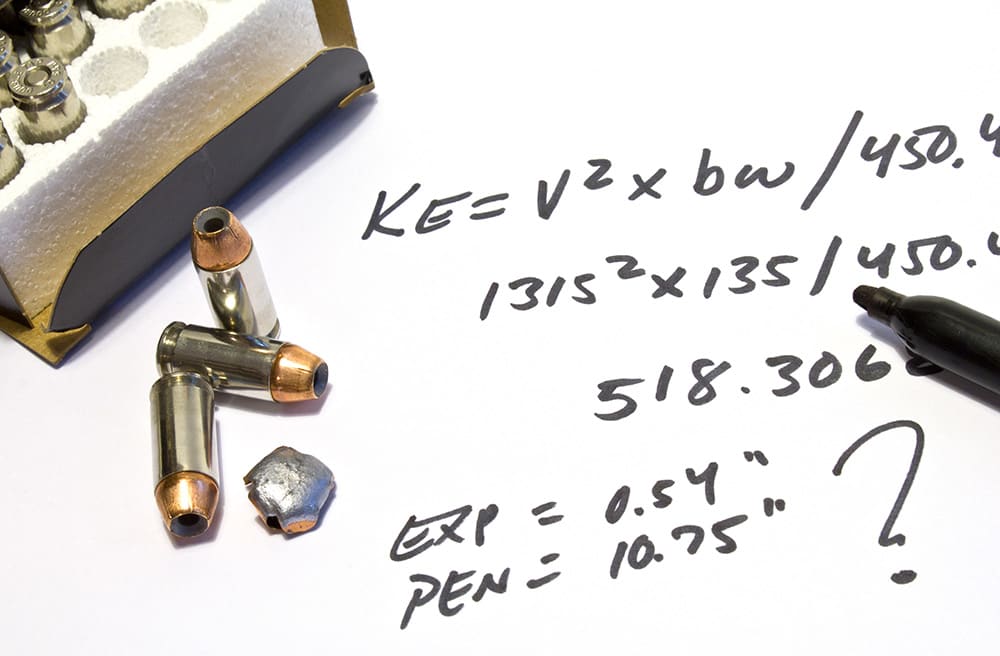Shooting with the Mann: Defensive Handguns and Kinetic Energy
Richard Mann 11.28.16

Kinetic energy is the energy of motion. With regard to ballistics, it is expressed in foot-pounds (ft-lbs) and represents the bullet’s ability to do work at a certain speed. Because a bullet begins to slow the moment it exits the barrel, its kinetic energy decreases as it travels downrange. You can compute the kinetic energy of a bullet by squaring the velocity and then multiplying it by the weight of the bullet in grains; finally, divide the product by 450,400 (velocity2 x bullet weight/450,400).
A bullet is a tool we use to do work, to punch a hole in something. If you look at bullets as tools used in a defensive situation, we hope the hole they make will stop an attack. Commonsense would seem to suggest that the bullet that will do this best is the one with the most kinetic energy. The conundrum comes from the fact that bullets work in different ways based on how they’re made.

For example; a full metal jacket (FMJ) isn’t designed to expand, but a jacketed hollow point (JHP) bullet is. An expanding bullet will work differently than a non-expanding bullet. To illustrate this, let’s compare two .45 Auto bullets. A 230-grain Federal FMJ bullet with a muzzle velocity of 900 fps will penetrate more than 31 inches of 10 percent ordnance gelatin. By contrast, a 230-grain Federal Hydra-Shock JHP bullet with a muzzle velocity of 900 fps will penetrate only about 15 inches. Both bullets have the same kinetic energy – 413 ft-lbs – but work differently.
But what happens when you compare two identical JHP bullets that are traveling at different speeds? Obviously, since kinetic energy is heavily influenced by velocity – velcoity2 – the bullet traveling the fastest should be able to do the most work. Sometimes the differences are minimal, and sometimes they are extreme.

When fired from a 4-inch barrel, Winchester’s 124-grain PDX 1, 9mm load will produce about 1,255 fps. From a 3-inch barrel, the same load will run at about 1,135 fps. At the higher velocity the kinetic energy is 433 ft-lbs compared to 354 ft-lbs at the slower velocity. You’ll see only about 1 inch difference in penetration in 10 percent ordnance gelatin. Conversely, Remington’s 115-grain, JHP, 9mm load produces on average, 1,209 fps (373 ft-lbs) and penetrates almost 13 inches when fired from a 4-inch barrel. Out of a 3-inch barrel, that same load generates around 987 fps (248 ft-lbs) and penetrates 20 inches.
Why the difference? In the simplest terms, the PDX1 bullet was designed to work similarly at the velocity and energy levels produced from both a 3- and 4-inch barreled handgun. With the Remington JHP load, there was not enough energy or velocity produced from the 3-inch barrel to make the bullet work like it dose when fired from the 4-inch barrel. It expands less, so penetrates deeper.

Where kinetic energy comparisons really fail to represent actual terminal performance is when bullets of a different design are compared. Speer loads their 155-grain Gold Dot bullet for the .40 S&W to a verified velocity of 1,222 fps (513 ft-lbs). DoubleTap loads a 135-grain Nosler JHP bullet for the .40 S&W to a chronographed 1,315 fps (518 ft.-lbs). Even though the kinetic energy numbers are almost identical, the Speer bullet penetrates 21 percent deeper. The kinetic energy numbers also don’t show how wickedly the Nosler bullet destroys the inside of the gelatin block.
Without some allowance for the way different bullets behave as they expand, kinetic energy by itself is not a reliable indicator of the lethality of a particular load, or of its ability to damage tissues. It is, however, a very good indicator of recoil. The old physics axiom that for every action there is an equal and opposite reaction, stands true with handguns just like everything else.


